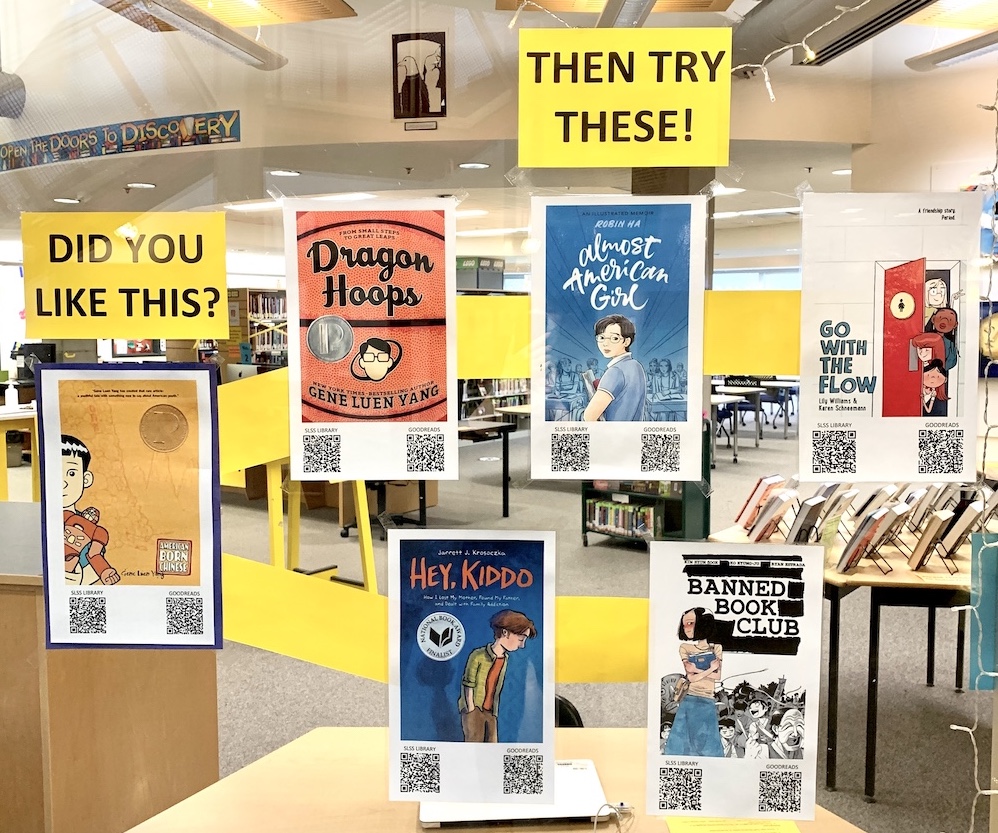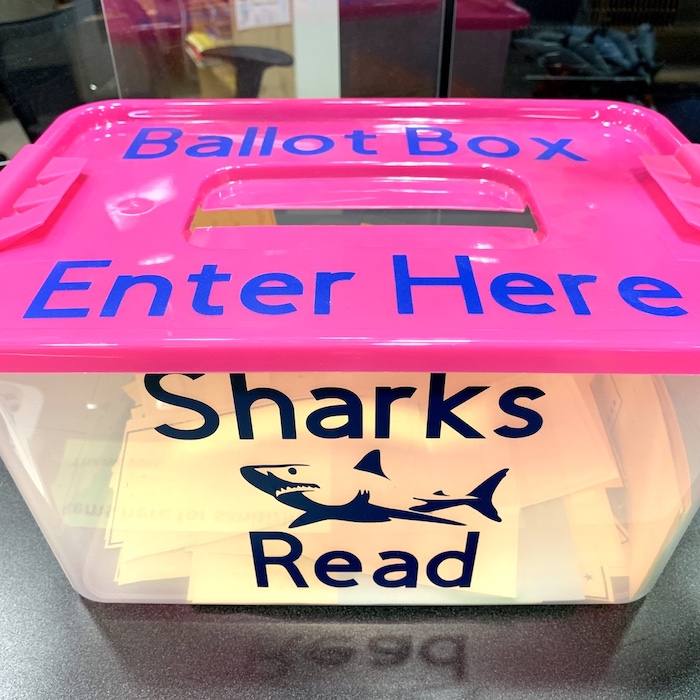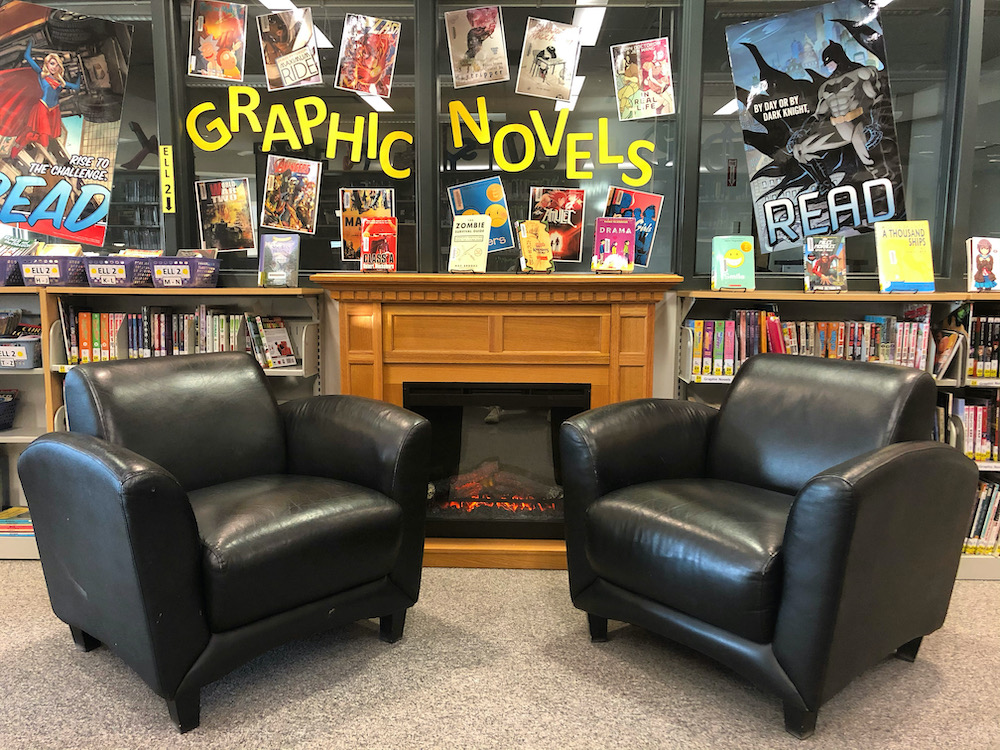Inquiry Blog Post #1
As a Librarian and a former English teacher, fostering a lifetime love of reading is the closest thing to my professional heart. I love matching students with books, talking with them about books, overhearing them having discussions of their own, and getting suggestions for what I should buy for the LLC. To keep all that going, I think the most vital elements to any LLC reading program are choice, time and community. I agree with Gallagher and Danladi that students’ reading choices must be respected and encouraged so they don’t lose interest in reading or become discouraged by material that is too difficult. I also agree that giving them enough time to read is important for the development of their reading, writing and language acquisition skills. When I had classes, my students were given 20 minutes per day to read a book of their choice, a quiet time that they quickly came to appreciate. Now that I’m in the LLC, it’s been exciting thinking up new ways to build a culture of reading!
Collection
In their case study of a high school in Singapore, and in the associated video (below), Loh et al. argue that a collection that meets the needs and interests of its students will be successful in attracting student readers. They also note that a smaller, well-curated collection can result in higher circulation than a larger one with more dead wood in it.
I have found this to be true myself. During the COVID quiet, we worked hard on our collection, including:
- Doing a major weed of our fiction section, which opened up more shelf space for forward-facing display. Circulation went up!
- Carrying out a diversity audit of our fiction section looking for markers of race, gender, faith, (dis)ability, and sexual and gender diversity. The results have allowed us to target our buying to address shortfalls (e.g. protagonists of Asian, African and Muslim heritage).
- Continuing to ensure the collection has a diversity of reading levels in every subject, from wordless storybooks to adult-level non-fiction.
- Seeding other teachers’ classroom libraries by giving away my old classroom library.
- Reorganizing our sections to better appeal/match to non-fiction leisure readers and English language learners.
- Making purchases based on student and staff requests.
Next year, I plan to greatly expand our manga section in response to student demand and start a student suggestion box.
Communication/Community
In the case study videos of the schools in Singapore (above) and New Zealand (below), communication – “making things visible” – is presented as a major factor in helping students encounter books they find interesting and feel more connected to the LLC. They also note the importance of giving students reading role models (staff or students) and opportunities to build community through discussion of the books they’re reading. I agree with all of these points!
In the past year I have:
- Put together several window and table displays on particular themes, e.g. “If You Liked This Book …,” anti-racism, freedom to read, new arrivals, etc.
- E-mailed staff about special displays or new books that have come in.
- Given book talks to any class in the LLC that would let me.
- Sent notices about events, etc. home to parents through the school’s “Week-at-a-Glance” newsletters.

We also started a new reading challenge to encourage students to come to the LLC despite some very discouraging COVID restrictions. If students finished reading a book from the LLC, they could fill out a prize draw ballot for a chance to win an e-gift card to a store of their choice (funded by our PAC). I acknowledge that many reading experts would disagree with this strategy, but it was a very challenging year for foot traffic, and the prospect of prizes did pull students in and get them excited. I’m wondering if I should do it again next year to help re-establish the LLC in the minds of our students. I would love to know what you think of this idea!

To further encourage community-building, next year, I plan to:
- Offer reserved lunch-time tables for book clubs. We are slowly developing book club sets.
- Use shelf-talkers with student reviews
- Arrange visits by local authors (e.g. Wendy Phillips, author of Baggage and Fishtailing)
- Offer workshops in the LLC on 3D printing, university application essays and writing fan fiction
- Create a display and/or video about teachers’ favourite reads
- Explore the idea of senior students becoming reading role models
Supporting students with technology
This year, we:
- Started an Instagram account to let students know about new books, events and library how-tos. Chin et al. point to the importance of taking advantage of social media to connect the LLC with students. We have definitely had students rush to the LLC when a new book has been advertised on Instagram.
- Used QR Codes in book displays to connect students to Goodreads reviews and the book’s catalogue record.
Next year, we plan to:
- Offer students greater access to our technology, such as cameras, microphones and laptop chargers. So far, teachers have been the only ones who can sign out technology.
- Expand our e-book and audiobook offerings. Biancarosa notes that it is important to offer students a variety of book formats, especially for those with physical or cognitive challenges. We also plan to promote these resources more heavily.
Policies
This year we:
- Eliminated late fees. We found they were discouraging students from coming to the LLC. Even though the fines gave us a handy revenue stream, we think it’s worth it to leave them behind.
Next year, we will be:
- Exploring the possibility of summer sign-outs. I was impressed with the success of the “book breaks” in the video from New Zealand.
- Allowing eating in the LLC; it’s been forbidden so far. We have a relatively short lunch, and we feel more students will come to the LLC if they can eat there.
Physical design:
- We will also be removing the sensitized gates at our entrance. They haven’t worked for years, other LLCs in my district are removing them, and I can’t wait to get rid of the physical barrier!
- Loh et al. discuss Library design at some length, especially the importance of creating quiet spaces for students to read and collaboration spaces for group discussion. They emphasize that for an LLC to physically support a reading culture, it needs to make students feel comfortable in sitting down to read on their own. Right now, we have collaboration (work) space, a Makerspace, and social space (leather couch and chairs in front of an electric fireplace) but no “quiet” space as such. I’m considering what to do about that, including possibly purchasing noise-cancelling headphones for students who might want them.
I am looking forward with much anticipation to a busier year in my LLC, and to further developing the culture of reading in my school.

References
Biancarosa, G., & Griffiths, G. G. (2012, Fall). Technology tools to support reading in the digital age. The Future of Children. https://www.jstor.org/stable/23317415?pq-origsite=summon&seq=1#metadata_info_tab_contents
Danladi, D. R. & Soko, Y. R. (2018, October 31). The role of school libraries in promoting reading culture among secondary school students: A case study of Federal Government College, Jos. Library Philosophy and Practice. https://web.b.ebscohost.com/ehost/pdfviewer/pdfviewer?vid=1&sid=64da452f-2b1a-4add-8dad-d3f72db07973%40sessionmgr101
Gallagher, K. (2009). Readicide: How schools are killing reading and what you can do about it. Stenhouse Publishers.
Loh, C. E., Ellis, M., Paculdar, A. A., & Zhong, H. W. (2017, September 26). Building a successful reading culture through the school library: A case study of a Singapore secondary school. IFLA Journal. https://journals.sagepub.com/doi/full/10.1177/0340035217732069?utm_source=summon&utm_medium=discovery-provider
National Library of New Zealand. (2014, November 16). Creating a school-wide reading culture [Video]. YouTube. https://www.youtube.com/watch?v=kiOZQFLTwmQ&t=3s
Office of Education Research – NIE. (2018, March 23). NIE research in practice series: Building a reading culture through school libraries [Video]. YouTube. https://www.youtube.com/watch?v=vKKUQB91YII

This is a strong post with so many excellent ideas and takeaways. I appreciate the way in which you have shared what you have done this year and what your plans are for the future. Our space and our practice need to evolve to meet the needs of our school community and you have nicely modelled this.
I personally don’t disagree with you using a little extrinsic motivation to pull students into the library! We have to help students develop the intrinsic motivation for things like reading, but we can’t do that if they’re not even in the library! Stores pull us in with draws and prizes, why not a library? I love that you’re working so hard to engage your students with reading. Have you thought about reserving tables for other clubs during lunch? It sounds like your book club students might be the ones already frequenting the library…what do you think? Only you know your students!
Thanks, Lauren. That’s a great idea to develop connections with our other clubs. At the moment, clubs have lunch meetings in the classroom of the teacher who is sponsoring them. Also, my school has such numerous (over 50) and active clubs, I don’t think the Library could handle the numbers. If you can imagine — several years ago a colleague and I started a knitting club. We figured a dozen sedate, tea-sipping girls would show up. 90 students came — we needed three classrooms to handle it. About 30% boys, who screamed knitting instructions at each other like, “NO! When you’re casting on, you hold your fingers like a gun. LIKE A GUN! No, Trevor, you’re f’ing it up!!!” It was knitting mayhem. But getting clubs into the Library somehow is a really good idea. I will have to think about how to do that. Thanks for mentioning it!
Andrea
Hi Andrea,
This may be just a weird case of Deja-Vu, but I swear I’ve heard your knitting story before! Did you attend the BCTLA conference in Surrey and are you a Richmond TL?
If not, that’s crazy! I love that you tried a knitting club, and I hear you about the volume of students and clubs in your school.
I did, and I am! We must have had a chat there because I sure didn’t present. That is wild! Also — if you’ve heard it twice, it’s probably time to retire that story, eh? : )
Hi Andrea,
Using Instagram to promote new books, events and library how-tos is a very useful idea and I also love the use of QR codes to link to Goodreads reviews.
Another idea we both described is the importance of role models: everyone, but especially adults should make a conscious effort to read in public and encourage others to read.
Moreover, I appreciate that you reminded us the importance of weeding the LLC collection and giving books to classroom teachers. I just hope you’re not always giving them old books you discarded :-p
Alex D.
Haha, no! I just gave teachers doubles of what we already have. I promise, I’m disposing of library discards responsibly. : )